Alexander Duncan
Interview by Emma Kelly
Published June 2017
-
Alexander Duncan brings together sculpture, new media and print, to question what is real and what is constructed. The artist explores the materiality of objects, the physicality of their being, and their semantic language. For Duncan, there is no such thing as the innocent object devoid of meaning; once an object is happened upon, it becomes an event of heightened perception and narrative.
-

cove, polyurethane , polystyrene, as part of ‘Offshore: artists explore the sea’ Ferens Art Gallery, Hull, 2017.
Image courtesy of David Chalmers
Your work draws inspiration from the fragility and power of the natural world. Can you tell me more about how your practice is informed by our changing and vulnerable environment?
I grew up in Swansea and along the coasts of Gower and Port Talbot was where I discovered a landscape dominated by the elements and expansive surfaces. It was a space where different senses were heightened; looking back it became an experiential way of learning. At 26 I moved to London for work, which in contrast is an area dominated by people and architecture, so a different kind of physical flow and surface. Having spent time in between the two cities I think the duality of space opened up ideas for new work and increased things I've become fascinated by.
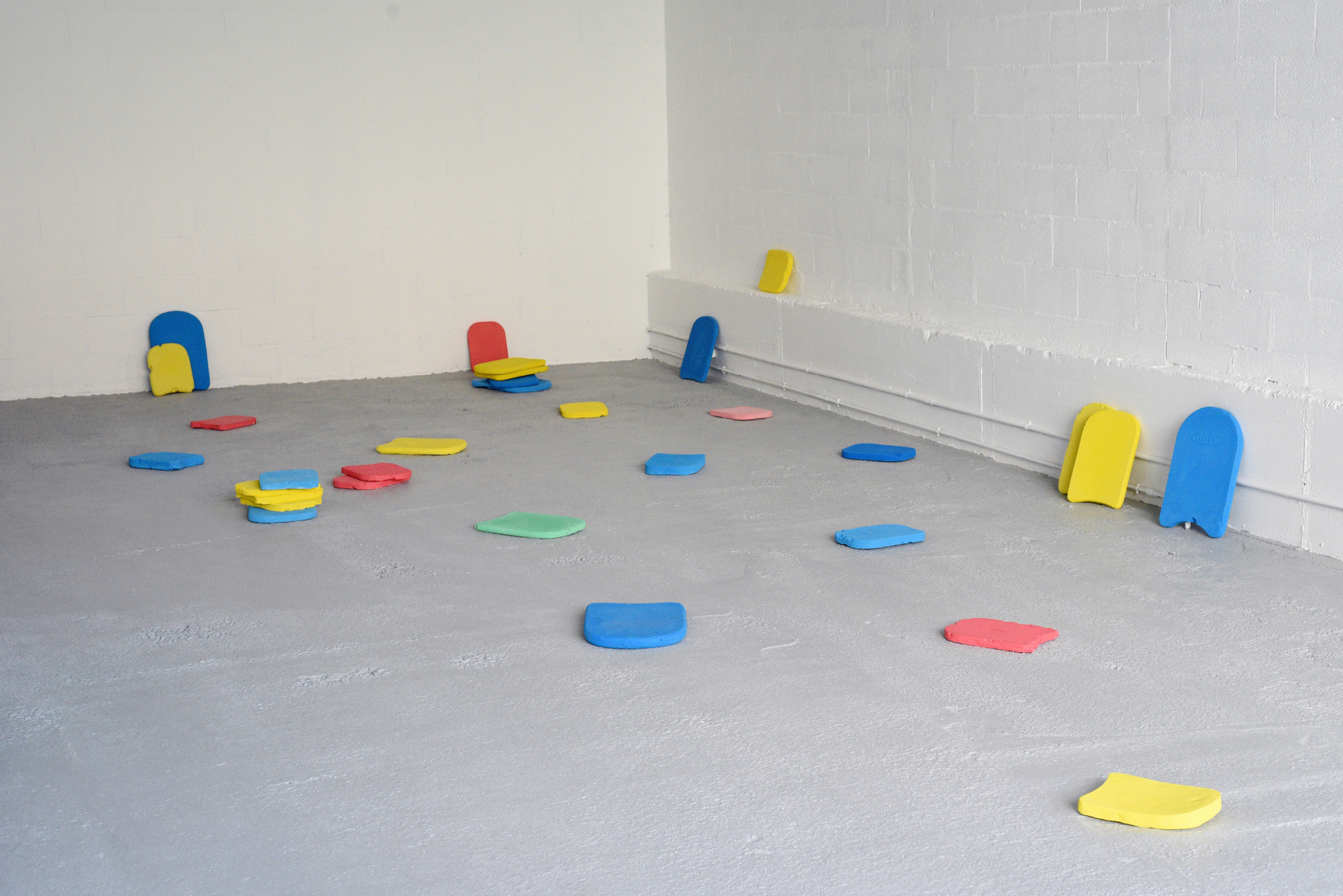
like swimming, concrete, pigment
Installed at Aldama Fabre Gallery, Bilbao, 2015-2017.
Image courtesy of Aldama Fabre Gallery, Bilbao.
A sense of immersion and play intervene throughout your work. We see this with your central work ‘like swimming, 2015-2017’, comprising a navigation of electric blue and yellow buoyancies cast in concrete. Here you skilfully play with the objects materiality to give us a float that will not float. What is significant about the float itself and its utility / function?
I am really interested in the floats’ marks, scratches and bites, which suggest a childlike connection to play but also to fear and anxiety. The floats are borrowed from my local swimming pool, cast and colour matched then returned, with each one having a one-off re-creation. In this way, the marks are traces of an experience where no images are allowed. It is quite a whimsical yet melancholic piece at the same time.
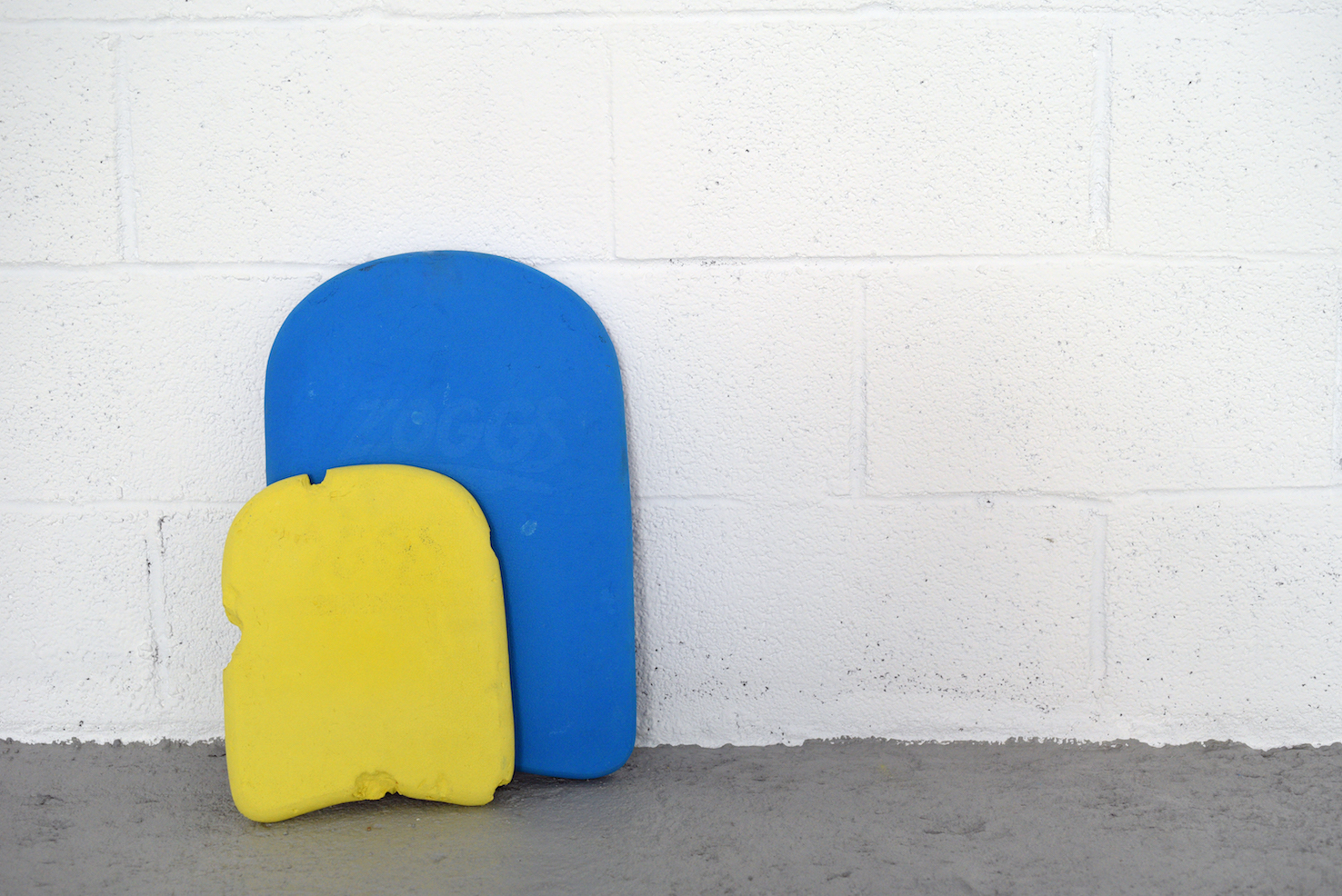
like swimming, concrete, pigment.
Installed at Aldama Fabre Gallery, Bilbao, 2015-2017.
Image courtesy of Aldama Fabre Gallery, Bilbao.
A float is a buoyancy, so there is also a connection to politicised figures in water in today’s society and contemporary media. To float becomes a political act: to be off somewhere, to be floating near something, to be in transit and off the edge. My titles are often ‘off’ the land or off something else, for example ‘hold down (off Biscay)’. The work is in the water, not on the land, and it is off the body.
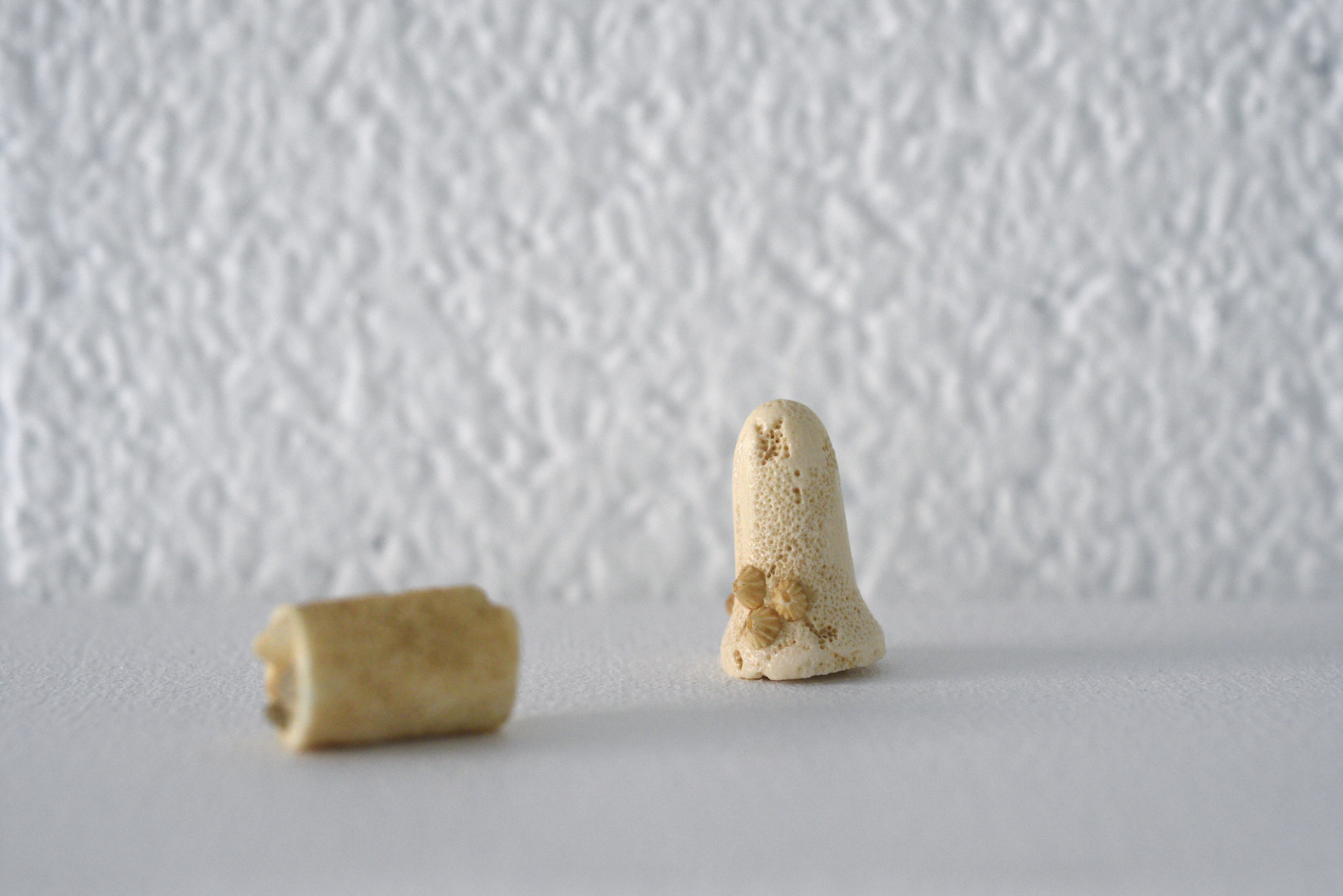
surfer’s ear, carved whale ear bone, 2016.
Image courtesy of Aldama Fabre Gallery, Bilbao.
You seem to spend as much time in the landscape as in your Battersea studio, picking through the detritus you find beneath your feet. You have a rare talent as you select and recreate. Can you tell me about what brought you to picking up the objects that feature in your new solo exhibition at Aldama Fabre Gallery, Bilbao, Spain?
I would commonly discover earplugs washed up by the Thames’s tide, and, like the floats, these items sit on the edge of two diverging states: noise and silence. I was fascinated by the bodily intrusion of denying yourself a sense, by ramming a piece of shaped foam into your ear. ‘surfer’s ear’ is hand carved from a found whale ear bone. In using this material, I hoped it would allude to the unknown effect that oceanic noise pollution has on a mammal’s communication. It was also the only part of the whale that would survive the smelting process.
The title refers to a bone growth, which forms through extended periods of immersion in cold water - the human body’s reaction to its environment. The growth is something they've recently found in ancient skeletons, that adds to the controversial ‘aqautic ape theory’ championed by writer Elaine Morgan. I came upon this idea of it being a specific whale ear bone material. Upon researching the idea of the whale ear bone further, things linked together and it made sense.
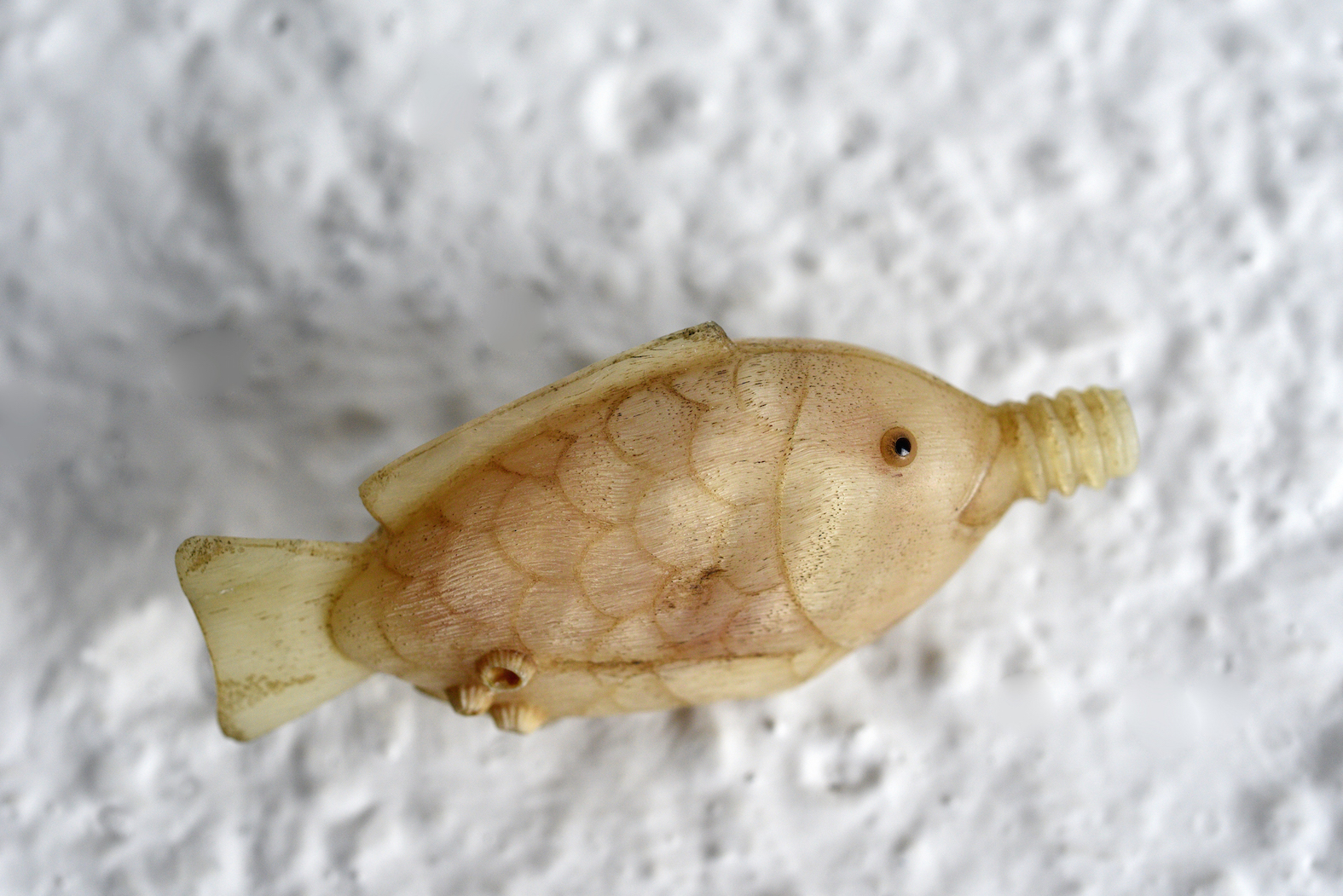
netsuke, carved rams horn, black buffalo horn, mammoth tusk (in collaboration with Peter Welsh), 2015. Image courtesy of Aldama Fabre Gallery, Bilbao.
Another object I found in the Thames debris was a takeaway sushi soy sauce bottle, which informed the ‘Netsuke’ series. I was fascinated with the decadence of the takeaway bottle, and how a decision was made for it to be small plastic fish. There seemed to be a great connection to that of the historical Japanese netuske, itself a decadent object. I then worked closely with a contemporary netsuke carver to create this work, where we elaborated on the design and meticulously hand carved the work from bone. It was the first time I had worked collaboratively on a piece of work, so that too was an exciting development in ways that i could potentially make work.
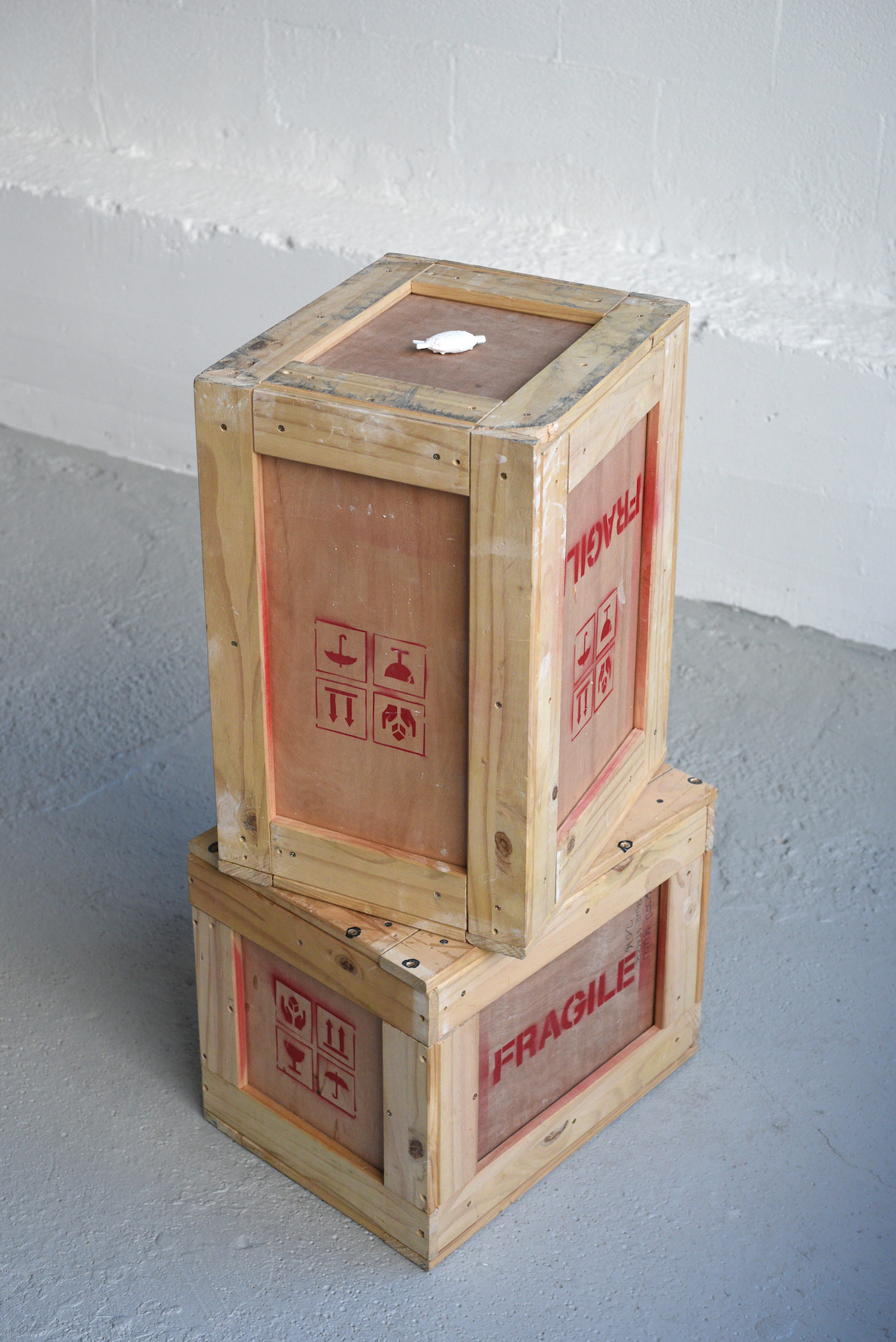
slip (netsuke), slip cast porcelain, 2017.
Image courtesy of Aldama Fabre Gallery, Bilbao.
Unique for Bilbao, you have elegantly recreated the object in porcelain?
Yes ‘slip’ echoes that of the carved work. I wanted the porcelain to continue the theme of material movement from one part of the world to another: the fluid of thought that underlies my work.

relief (poster), gelcoat, pigment, fiberglass diptych, 2017.
Image courtesy of Aldama Fabre Gallery, Bilbao.
Other work that came from visits to Bilbao are the new wall pieces relief (poster), 2017 and relief (notice), 2017. They developed from the visual language of the city; I was fascinated by the surfaces that define public space like the many posters, flyering, and colourful murals that line the streets, a melting amalgamation of layers. These new works have a certain harmony, yet enough detail and impact, which offer an interesting cross connection between the white objects and something that can sit with a kaleidoscopic drift of floats.
One of my favourite aspects of your work is how your unique aesthetic takes the viewer to an unexpected edge between reality and illusion, provocatively questioning our own sense of such certainties. This is evident in your latest works, which continue to explore the representation of immersion.
Yes, these ideas are present in the ’hold down (off Biscay)’ video, which suggests people being lost / sucked into something. The fun of having a GoPro video attached to your body whilst surfing (giving a ‘POV’ view of events) is elongated, focussing on a point where the wearer is underwater having lost control of the situation and is being tossed around uncontrollably in the washing machine of a rolling wave. The video questions our particular kind of disconnection with sensory experiences of oceanic spaces and offers an opportunity to immerse within the thresholds of the water and identify new, non-human peripheries.
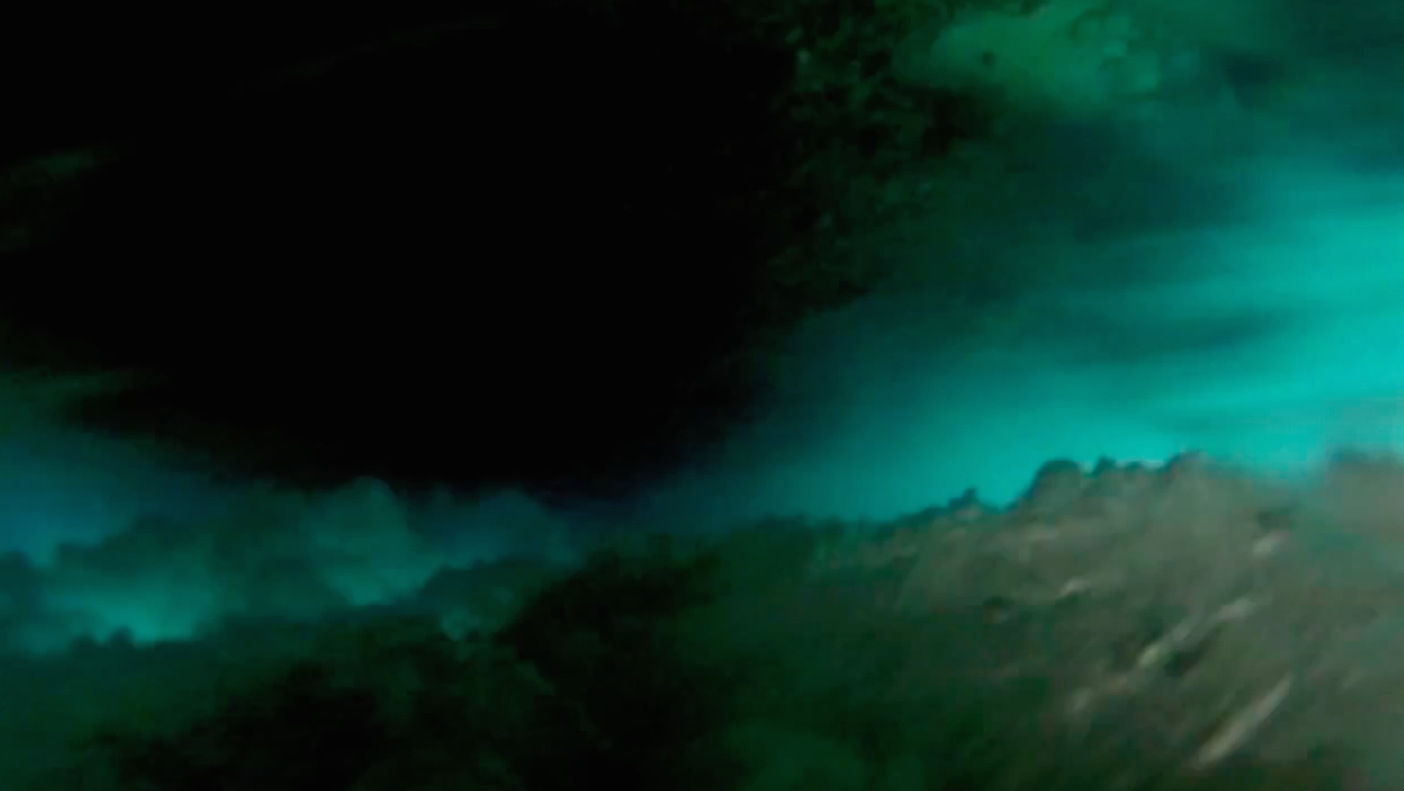
hold down (off Biscay), digital video collage, 2:40, 2016
Similar ideas are present in ‘frothing’, a surf wax cast of my studio’s ceiling. The texture is like that of an open ocean swell, something you might see from an airplane. I like to use materials that are not always ‘artwork’ materials, yet have a similar connection to recreation, re-creation, and the way people experience the world. The smell and feel of it echoes the rhythmic way a surfboard is waxed, and how through hand casting the ceiling it brought back to me that ritualistic feel.
Can you speak about the importance of the material for your works?
For me, the idea of touch is so affecting. I am not sure what it is, but I have always been fascinated by what I’ve come to know as haptics. Beyond the visual immediacy exploring ideas of the other senses, or notions of scale and preconceptions of what soft or hard (brexit) mean any more.
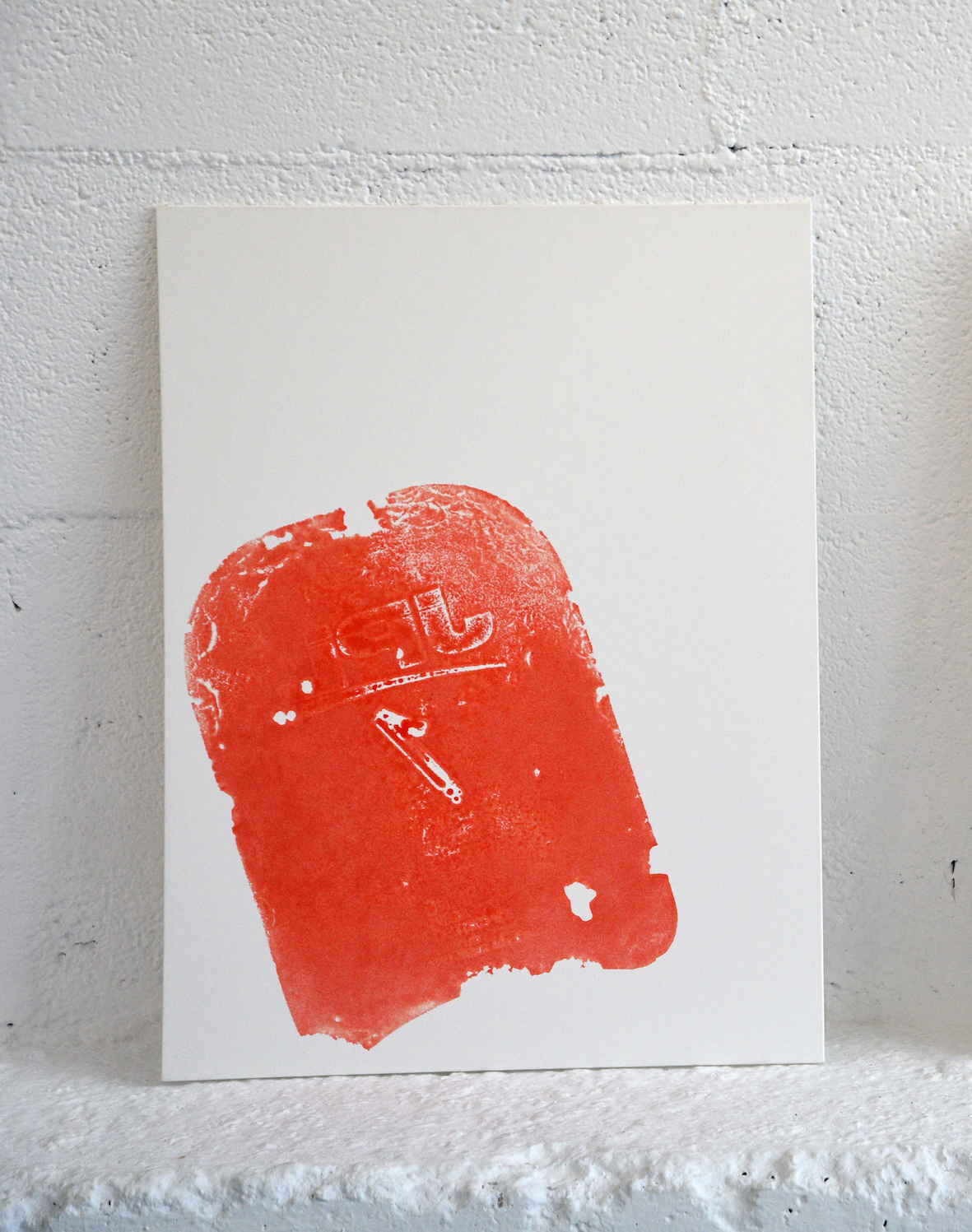
like swimming (red room), block print, cotton rag somerset paper, 2017.
Image courtesy of Aldama Fabre Gallery, Bilbao.
Your latest work also sees you experimenting with printmaking, seen in your series of float prints ‘like swimming (red room)’. How have you found working in this medium and can you tell me more about the sub title ‘red room’?
Following a similar idea to the cast works, the float’s primitive markings, hiding unseen events, reappear here. They began with an excitement to experiment; maybe subconsciously there was this idea of printing as idea of an immediate mark. There is something wonderful and immediate about using a float as a block print, as something to leave an imprint. A ‘red room’ refers to a mythical unseen space on the dark web, where people have found it hard to prove its existence or verify that it is a false entity.

wake, banner suspended on La Carola Crane, Bilbao, 2017.
Image courtesy of Aldama Fabre Gallery, Bilbao.
Parallel to the exhibition, you are presenting an ambitious new project, suspended on Bilbao’s iconic La Carola Crane. How did you approach the commission?
La Carola is iconic in the landscape of Bilbao, it represents pre–Guggenheim, pre-revolution of the city centre; the crane is iconic for ideas of city and legacy. I needed to tread carefully in how any artwork could interact with the structure – after all there is no competing with a 100 ton bright red crane. The idea of the banner came about through collaboration with the Ria de Bilbao Maritime Museum and Bilbao Art District, who supported the commission. The potency of scale was very interesting and I wanted to use the idea of La Carola’s height to explore a sense of depth.
The work is inspired by the strong connection Bilbao has to the tidal river and through it beyond, the ocean. The resulting image you see is a photograph taken of a side of a shipping container. I felt a connection of liquidity the more I walked passed it and thought it could be something. In flux and change, the back peeling of paint revealing different colours and layers, and I suppose a thinness of time.
lacustrine, lambda cyanotypes mounted on aluminium, 2015
The work has a close connection to a series of puddle photographs I was working on called ‘lacustrine’. The dual reading of the work as something melancholic, of sinking or that of something energizing and immersive. The idea of renewal: to be within a material is something rare.
What other artists interest you and inform your practice
Guiseppe Penone is someone I grew up admiring, discovering the Arte Povera movement through artist like Tim Davies when I was in college, their poeticism with materials has always fascinated me. A simplicity and rawness of making work- to keep the object as something fascinating in a time when objects are deemed to hold less and less relevance.
At the RCA artists like Richard Wentworth, Densie De Cordova and Jordan Baseman were really supportive as lecturers, and my contemporaries in those years on the Sculpture course.
What can we see next from you Alex? And what are the key aims that drive your practice forward?
I have just been part of a group show ‘Uprootedness’ in New Cross, London, which has been great. I have a museum show opening in January, at the recently reopened Glynn Vivian Art Gallery in Swansea as part of ‘Ephemeral Coast’ curated by Celina Jeffery.
I co-direct ‘ArtLacuna’ project space in Battersea, where we have an exciting programme of artists showing over the next two years. I really enjoy this dialogue with artists as I find this interaction and collaboration one of the main things I really enjoy, the humanity of shared experiences.
-
Alexander Duncan lives and works in London. Selected solo exhibitions include Blow In, Aldama Fabre, Bilbao, Spain, Wakelin Award, Glynn Vivian Art Gallery, Swansea and Window project, Gazelli Art House, London. Selected group exhibitions include Offshore: artists explore the sea, Hull, Llanw, Plas Glyn Y Weddw, North Wales and dip, CBS Gallery, Liverpool.
-
If you like this why not read our interview with Rufus Newell
-
© 2013 - 2018 YAC | Young Artists in Conversation ALL RIGHTS RESERVED